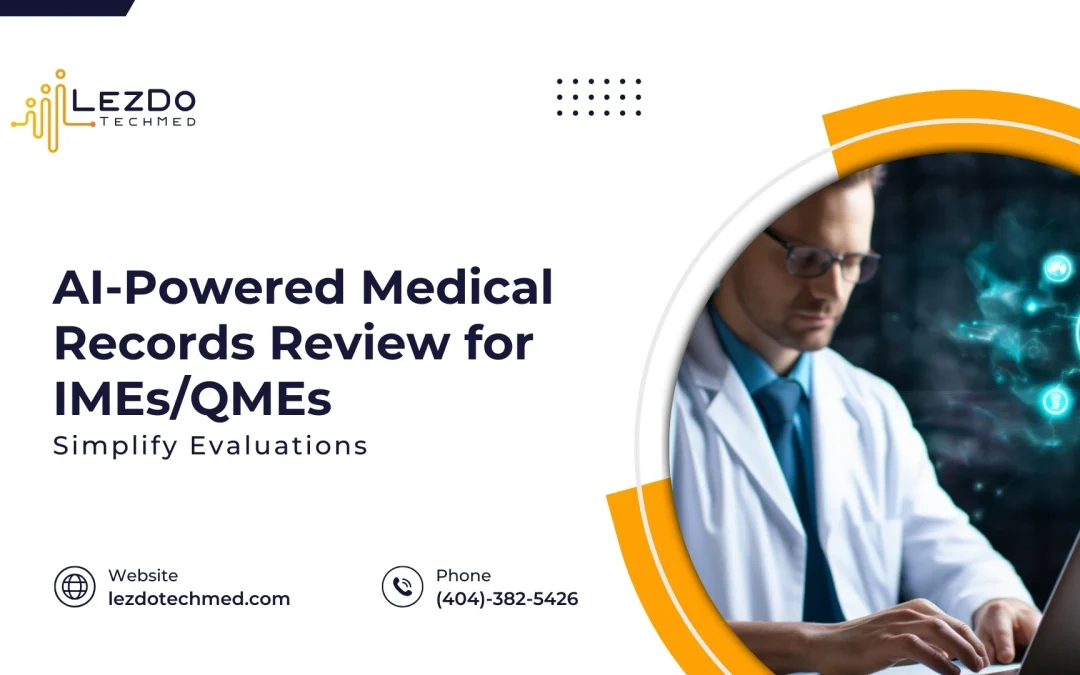In the intricate healthcare system, it’s all too easy for medical negligence to slip through unnoticed. Misdiagnosis, delayed treatment, and even unwarranted medical procedures – these are some of the dark avenues where medical negligence lurks. This blog shows you how such malpractices can be unmasked through powerful medical record reviews.
LezDo TechMed has vast experience in handling medical negligence claims. Trust on our expertise to bring the hidden evidence to light via our medical malpractice case review.
Ready to get started? Get free trial worth $500. Hurry up!

Understanding Medical Negligence
A medical provider failing to provide the standard of care that another qualified medical provider of his field would have given under equal circumstances is termed as medical negligence. When this substandard care results in a personal injury, emotional distress or substantial loss of income, medical negligence claim can be pursued. Negligence could range from a surgeon leaving a medical instrument inside a patient’s body post-surgery to a general physician misdiagnosing a critical illness.

Medical negligence can occur in any of these circumstances listed below.
Diagnostic errors
- Misdiagnosis: Misdiagnosis unfolds when a physician incorrectly pinpoints a patient’s ailment. It’s like having severe chest pain and being told it’s simply a case of indigestion. The patient receives treatment for the wrong ailment, while a potential heart attack goes unnoticed and untreated. This serious misstep can transform a manageable situation into a life-or-death crisis. The result could be fatal, an avoidable tragedy borne from a diagnostic mistake.
- Failure to diagnose: This happens when a significant illness isn’t detected at all, causing the disease to worsen before a correct diagnosis is made. Imagine a situation where early-stage abdominal cancer is overlooked by the treating physician or the radiologist. With the disease unchecked and untreated, it escalates over time. By the time the cancer is finally detected, it has advanced to a more critical stage. This results in a need for intensive treatment and worsens the patient’s physical as well as emotional well-being.
- Delayed diagnosis: Delayed diagnosis of a patient’s illness means they can’t start treatment early, making their recovery longer and harder. Delayed diagnosis not only hinders the treatment on time, but it also intensifies the patient’s pain and distress. In essence, a delayed diagnosis is like a double blow to the patient – fighting the disease and the extended treatment due to late detection.
Surgical errors
Surgical errors like sponges or surgical tools mistakenly left inside bodies or operations conducted on the wrong site are more than just nightmarish tales; they’re dangerous reality checks. In some cases, the surgeon may accidentally injure a nerve or vein, or operate or amputate the wrong limb. These scenarios will end up in permanent scarring or disability.
Surgical errors are instances of deep-set negligence that can cause severe health issues, extend recovery periods, or worst-case scenario, lead to an untimely death.
Birth injuries
There are several forms of medical negligence during childbirth that may result in birth injuries like the application of excessive force during the delivery process, pulling or twisting the baby harshly. Another form of negligence is the inability of medical practitioners to foresee and control maternal tearing or hemorrhaging.
Misuse of birthing tools such as vacuum or forceps during delivery and failing to properly educate a mother about the risks associated with forceps or vacuum delivery can be seen as negligence, as informed consent is a fundamental aspect of patient care.
In essence, these forms of medical negligence during childbirth are significant and carry the potential for long-lasting harm like cerebral palsy or brachial palsy.
Prescription drug error
Prescription drug errors happen when providers prescribe the wrong medication, the wrong dosage, or fail to consider how a new medication might interact with one the patient already taking. Sometimes, these mistakes are due to recklessness or a lack of attention to detail. Other times, they occur because the doctor is too busy or doesn’t have all your medical information. Whatever might be the reason, prescription drug errors can have serious consequences, potentially leading to health complications or even demise.
Anesthesia errors
Sometimes, anesthesia is not given on time, causing unnecessary pain and distress. Other times, the patient might get too much or too little anesthesia, leading to severe complications. There are instances when surgeons go wrong in choosing anesthesia for the procedures. If it’s something the patient’s allergic to, it spells nothing but danger for them. Even failing to properly monitor or handle surgical oxygen can be a mistake. This might sound technical, but basically, it means doctors are not paying close attention to how the patient is doing during the surgical procedures.
Failure to prevent or treat infections
Medical negligence can occur when the physician or facility fails to prevent or treat infections. The physicians and nurses owe a duty of care to make sure the patients don’t get infections. This means they should keep everything clean, wash their hands often, and follow all the rules about preventing infections.
When they don’t follow these protocols leading to the patients getting sick because of it, that’s medical negligence. Also, if there is already an infection, they must treat it properly. They should administer correct medications, do regular check-ins, and take all essential steps to improve their health. If they fail in doing so and the infection gets worse, that’s also medical negligence.
Difference between Medical Negligence and Medical Malpractice
Medical negligence and medical malpractice have a hair-breadth difference. Medical negligence is when a health care provider accidentally commits an error, which leads to the injury of a patient. Medical malpractice is when a healthcare provider being aware of the complications of a surgery or treatment, performs it without getting the consent of the patient or without following proper protocols to avoid the mistake and harms the patient.
However, remember, basically a medical negligence forms the base of a medical malpractice lawsuit.
Medical Negligence Law
Medical negligence also falls under medical malpractice law, which is in turn the part of tort law dealing with professional negligence.
Medical negligence law considers four D’s listed below:
- Duty of care: The healthcare providers owe a duty of care to every patient comes to them. Duty of care means properly testing and diagnosing the illness, giving standard treatment expected of them and following up until they get cured.
- Dereliction of duty: Dereliction (breach of duty) means deviating from giving the standard care to the patient, which a professional would not have done in similar circumstances. All those types of medical negligence we have discussed above falls under the dereliction of duty.
- Direct causation: When the provider’s breach of care directly results in the injury of the patient, the provider is liable. However, the patient’s negligence in following the instructions of the provider or chronic pre-existing condition worsened the situation leading to the harm, does not hold the provider liable.
- Damages: The injuries or harm encountered by the patient due to the recklessness of the provider is the damages. This covers both past and future medical expenses, income loss, and diminished future earning potential. It also accounts for partial or permanent disability, endured pain and discomfort, a reduction in life quality, loss of companionship, and the loss of life itself.
We have seen different types of medical negligence that prevails in the healthcare arena. However, proving negligence can be an uphill battle, and it is here that medical record reviews come into play.
The Role of Medical Records in Healthcare
Medical records serve as the backbone of healthcare system. These comprehensive medical documents outline every detail of a patient’s treatment course – the initial diagnosis, the progression of the illness, the chosen treatment, and the follow-up care. Any discrepancy, negligence, or malpractice leaves its footprints here. Unveiling these clues can become a turning point in cases of medical negligence, thus necessitating the need for a thorough medical record review.
Medical Negligence: A Lurking Danger
One might think that medical negligence is a rarity, but it occurs being unnoticed. With alarming frequency, medical professionals deviate from established norms and protocols, leading to patient harm. But this widespread problem often goes unchecked due to a lack of adequate scrutiny.
How can a detailed record review unearth medical negligence?
A detailed medical record review for healthcare systems by experts is akin to a potent magnifying glass, capable of uncovering the subtlest traces of malpractice. Every test result, every medication prescribed, every note from a nurse – can provide pivotal insights into the nature and extent of negligence. Moreover, these reviews can help establish a timeline, a critical factor in any legal proceeding.
Cracking the Code: How to review medical records?
Reviewing medical records is a nuanced process that requires medical knowledge and legal expertise. It’s about piecing together the medical jargon, interpreting lab results, and evaluating the appropriateness of treatment decisions. Working with experienced medical record review experts can significantly bolster your case, providing the evidence needed to prove medical negligence.
Key Indicators of Medical Negligence in Records
Identifying negligence in medical records involves spotting irregularities, inconsistencies, and deviations from standard care. This could include inappropriate medication dosages, contradictory diagnostic results, or unexplained delays in treatment. By sifting through these records, the vital evidence of negligence can often be unearthed.
Expert medical record reviewers will not leave any stones unturned to unmask the hidden traces of negligence. In some cases even a miscellaneous record can turn out to be a vital evidence, during medical negligence experts reviews.
Medical Negligence Cases Examples: Uncovering Negligence through Record Review
Failed to treat an infection
A 40-year-old patient succumbed to a treatable pressure sore turned sepsis shock due to a delay in diagnosis. The treating physicians and the registered nurses who took care of him did not give proper care for his pressure sores. A detailed review of his medical records revealed that his symptoms had been consistently overlooked, resulting in a delayed diagnosis and ultimately, his untimely demise. This case underscores the vital role of medical record reviews in exposing and proving medical negligence.
Delayed tumor diagnosis
In another case, the plaintiff experienced unusual fatigue and sweating in 2016. An eye exam revealed vision problems, but a hospital misinterpreted a CT scan, failing to detect a brain tumor. In 2017, his vision declined significantly. Yet, another hospital also misdiagnosed him. Only in 2020 was the tumor finally discovered and treated, leading to an improvement in his health and work performance.
A diligent review of his medical records illuminated the negligence surrounding his medical negligence lawsuit. Specifically, the misreading of the initial CT scan and delayed diagnosis were evident. These errors, only discerned through the thorough examination of his medical history, highlighted a stark deviation from the standard of care, causing prolonged distress for the plaintiff. The medical negligence reviews, thus, proved instrumental in substantiating the medical negligence claim and acted as a cornerstone for the subsequent legal proceedings.
Surgical error leads to PTSD
In 2014, the plaintiff underwent a procedure to re-site her PEG feeding tube. Unfortunately, a plastic disc was left behind, causing an infection. To exacerbate the situation, an additional procedure was performed without her consent or anesthetic, causing her considerable distress and exacerbating her PTSD.
The thorough review of her medical records revealed this negligence. It detailed the timeline of events, including the improper procedure and the lack of consent for the subsequent surgery. This careful review of her records was pivotal in unveiling the medical negligence involved in her case. It helped her get decent medical negligence settlement amounts.
Legal Aspects of Proving Medical Negligence
Legally, proving medical negligence cases can be a complex endeavor. The burden of proof lies with the plaintiff’s lawyer, who must demonstrate that the healthcare provider deviated from the accepted standard of care, leading to harm. A well-conducted medical record review can provide the requisite evidence, serving as the cornerstone of the medical negligence claim. With the help of medical negligence lawyers, the plaintiffs get compensation for their suffering.
The Impact of Medical Negligence on Victims
The repercussions of medical negligence extend far beyond physical harm. The emotional trauma, loss of faith in healthcare, and financial burden can be equally debilitating. Recognizing and addressing medical negligence is not just about holding healthcare professionals accountable – it’s about restoring faith in the healthcare system.
Ultimately, medical negligence is an ominous shadow over the healthcare field. However, having armed with the power of expert medical record reviews, victims can bring light to their plight, exposing the wrongdoers and seeking the justice they deserve. If you suspect the plaintiff has been a victim of medical negligence, don’t hesitate. Seek out experienced medical malpractice review professionals, and take the first step toward justice today to quicken the legal processes within the medical negligence statute of limitations.
Ready to Get Started?
Unearth the strengths and weaknesses of the claim with the help of medical malpractice record review experts like us. A free trial worth $500 awaits you. Time is of the essence, don’t wait! Claim your free trial now!
Ready to get started? Get free trial worth $500. Hurry up!
Follow us in Pinterest to get more insights similar topics.











